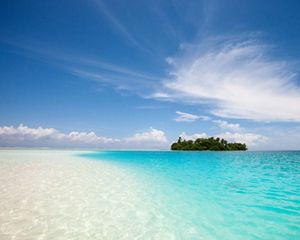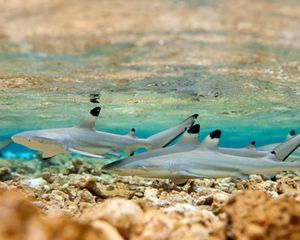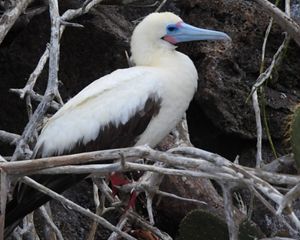Palmyra Atoll
Celebrating 25 Years of Conservation
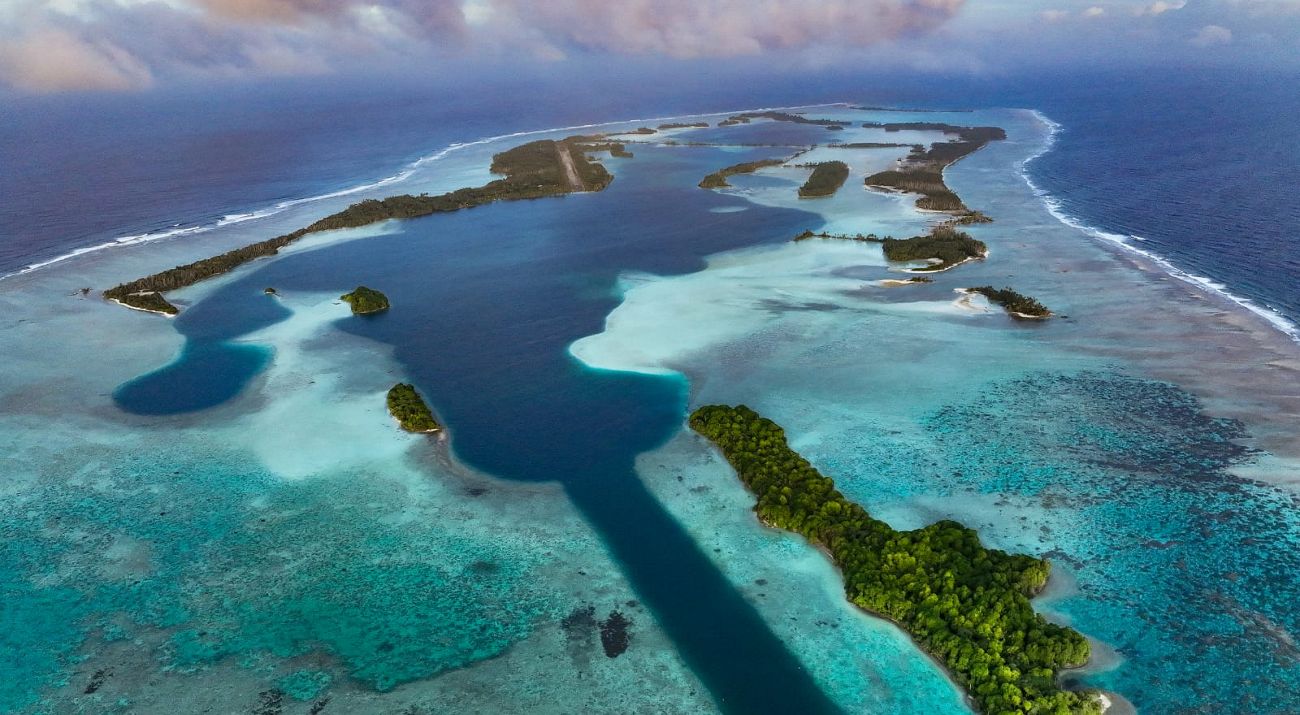
Make a Difference in Palmyra Atoll
It’s in our nature to protect what matters. When you donate today, you help ensure that Palmyra’s lush tropical forests, thriving coral reefs and deep blue waters remain a refuge for endangered species and an innovation hub for globally relevant conservation science. Help protect one of Earth’s great hope spots.
Palmyra Atoll: Tiny Islands, Planet-Sized Impact
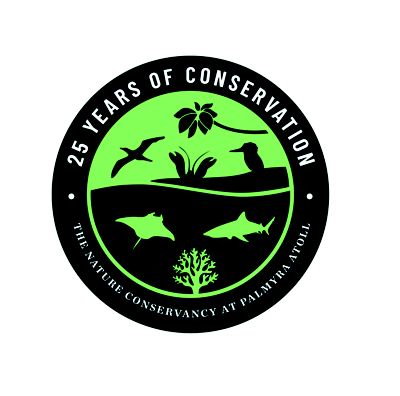
TNC’s Palmyra Atoll Preserve is a collaboration hub, a place of learning and a refuge for species on the verge of extinction—making it a hope spot for global conservation. Located far out in the Pacific, a thousand miles from the nearest city in Hawai’i, this amazing coral atoll is one of the few island and marine environments that is both spectacularly intact and also relatively accessible with facilities to support scientific research.
In the absence of people, Palmyra’s natural systems flow seamlessly from lush tropical forests, vibrant coral reefs to the vast open ocean. Scientists from around the world come here to better understand these ecological connections between land and sea, to research the effectiveness of large protected areas and to unlock the clues to climate resilience. These discoveries can help improve commercial fisheries management and build the resilience of islands and atolls worldwide.
Palmyra is a place that shows how resilient nature can be if we do our part. Here, nature rules: coral regrows, native species rebound and ecosystems once at the edge are thriving. Every restoration success story proves that when we give nature space to recover, it delivers abundance in return. This isn’t just conservation; it’s a blueprint for ecological stability and scientific discovery.
As TNC celebrates 25 years of protection, restoration and discovery at Palmyra, the lessons resonate far beyond its shores and can shape the future. Our ambitious global goals—and the urgency of climate change—bring the atoll’s scientific value into newly sharpened focus.
Our Vision
Palmyra is a conservation innovation hub and a hope spot. It teaches us how to better protect islands, reefs and oceans around the world and it inspires us about the true power of nature.

Research Station to the Pacific
With coastal erosion, sea-level rise, ocean warming and other climate impacts intensifying, low-lying coral islands like those at Palmyra are on the front line of global climate change. At Palmyra, TNC aims to provide a model for other Pacific atolls interested in finding ways to reduce local threats and build resilience to the impacts of climate change.
In 2018, TNC created the CARL Climate Adaptation and Resilience Laboratory (affectionately known as CARL) at Palmyra Atoll. The lab’s mission is to refine, amplify and accelerate the application of TNC’s nature-based solutions far beyond Palmyra. There are three key focus areas of this work that are designed to provide actionable solutions to global challenges: island conservation, coral reef resilience and ocean research.
Engineering a Rainforest to Protect a Reef
Palmyra’s tropical rainforest once dominated the atoll, but copra (coconut palm) farming, black rats and deforestation by the U.S. military during World War II reduced it to a few patches. Rats were eradicated from Palmyra in 2011, igniting a resurgence of native bird and plant life, and a major native rainforest restoration project is now underway to convert the abandoned copra plantation to native forest habitat preferred by seabirds.
Palmyra’s rainforest and surrounding coral reefs are interdependent ecosystems. The atoll’s native trees are preferred over coconut palms as nesting and roosting habitat for the tens of thousands of seabirds that find a safe haven at Palmyra. These birds deposit guano that enriches the soil, which is then flushed into the ocean by rain, delivering important nutrients that increase the resilience of the atoll’s coral reef ecosystem, including feasts for manta rays.
TNC is conducting innovative monitoring techniques, such as analyzing high resolution drone imagery, to document how increasing the native rainforest cover affects the seabird populations and nutrient cycling across the atoll. Research conducted by TNC and partners to understand the key drivers for atoll ecosystem resilience at Palmyra supports a TNC-led initiative to rebuild atoll ecosystem resilience throughout the Pacific.
Quote: Nick Holmes
By restoring seabird populations, we can also spur the protection of whole ecosystems—and all the benefits those places provide both people and nature.
Call of the Wild: Seabird Discotheques
In addition to habitat restoration, social attraction efforts led by TNC’s Island Resilience Strategy team are helping to bring seabirds back to the atoll. The team uses decoys arranged to look like real birds cuddling and plays seabird vocalizations over loudspeaker systems to entice birds to return.
Learn More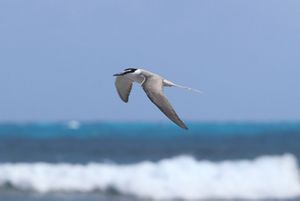
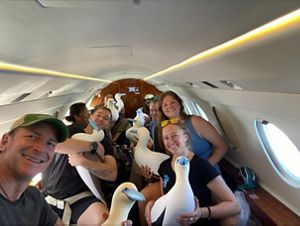
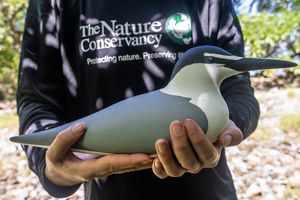
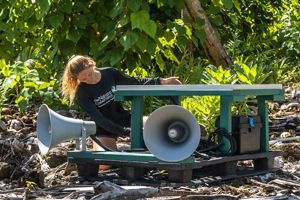
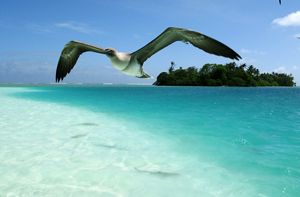

Palmyra Atoll: Grey-backed terns are now nesting regularly at Palmyra Atoll, thanks to the seabird social attraction project. © Martin Kastner

Palmyra Atoll: Operations and science team members head to Palmyra Atoll with red-footed booby decoys to test their effectiveness in attracting live boobies to new habitat. © TNC

Seabird Social Attraction: A grey-backed tern decoy at Palmyra Atoll. This species has successfully nested near one of the decoy colony sites three years in a row since 2022. © Sarah Glover

Palmyra Atoll: A loudspeaker plays calls of targeted seabirds at Palmyra Atoll. © Sarah Glover


Sihek are Flying Free and Thriving
As we work to resist extinctions around the globe, Palmyra’s protected and closely monitored habitat offers an invaluable opportunity. In 2024, we worked closely with a suite of partners to translocate nine critically endangered, extinct-in-the-wild sihek (Guam kingfisher) to Palmyra Atoll. All nine are doing well, and eight are in mating pairs and have laid at least one clutch of eggs.
This work was done in collaboration with several partner organizations but most importantly with Guam’s Department of Agriculture’s Division of Aquatic & Wildlife Resources and in consultation with the CHamoru people, whom we hope through this project will be able to plan for the return of the sihek to their island home in the years to come.
Learning from Healthy Coral Reefs
Palmyra Atoll is of global significance for coral reef research—especially in the face of climate change. With an absence of current, local human impacts and access to one of the world’s healthiest coral reef ecosystems, TNC and our partners are uniquely positioned to investigate the critical driving factors of coral reef health.
In addition to helping to create the world’s first-ever digital reef, our team on Palmyra is working with partners to better understand what makes some “super reefs” climate resilient, including by using new cutting-edge technology to monitor Palmyra’s reefs following a devastating bleaching event.
The Digital Reef
Developed at Palmyra, the world’s first digital reef replica allows scientists to digitally test potential actions that would be costly to test on-site due to the atoll’s remoteness. For example, the tool allows users to virtually plant corals to see where currents spread their larvae, and then select the best locations based on optimal dispersal.
Monitoring coral reef health across vast areas has traditionally been incredibly challenging and resource intensive. At Palmyra Atoll, we’re changing that by leading an international consortium to develop innovative drone and machine learning-based monitoring technologies to track reef health over vast spatial and temporal scales.
We are sharing these innovations with marine managers who need better tools to protect critical reef ecosystems, with applications expanding in Hawai'i, the Caribbean and other reef systems. Our goal is to empower coastal communities worldwide to safeguard their reefs and the lives and livelihoods that depend upon them.
Making the Most of Marine Protection
Giant bluewater Marine Protection Areas (MPAs) are one of the core global strategies for meeting 2030 conservation goals. So, how can we make these areas as successful as possible? Palmyra is an amazing place to try to answer this question.
From manta rays to sea turtles to melon-headed whales and shivers of sharks, Palmyra is a hub for a stunning area of marine species that live in the open ocean. The atoll provides a reliable source of food and shelter in the midst of the deep blue sea, making it a nexus point for many species as well as an amazing place for researchers to study them. For years, TNC has worked with partners at Palmyra to study the importance and effectiveness of MPAs—and we’ve made some incredible discoveries.
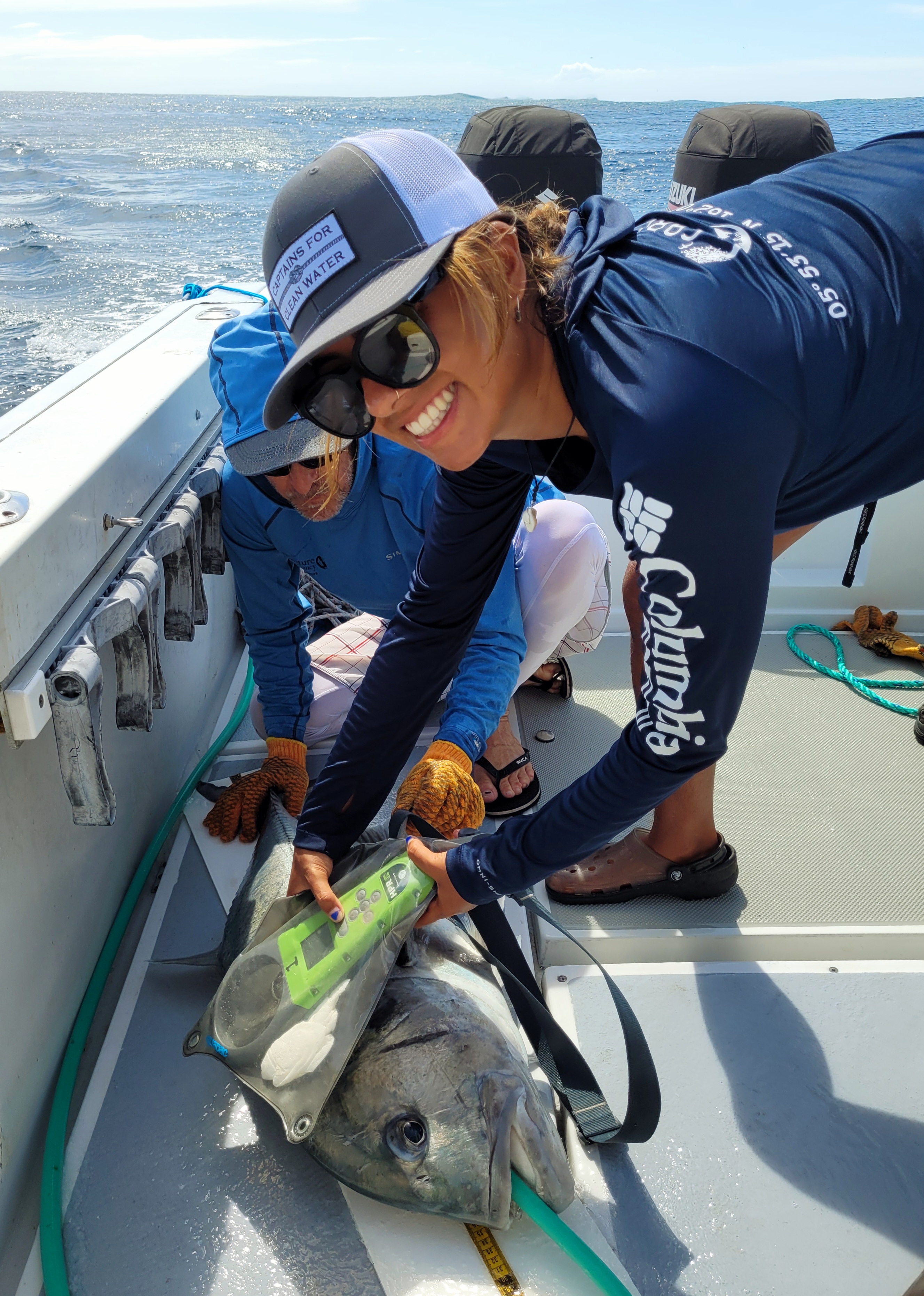
Follow the Fish: Tracking Reveals the Power of MPAs
To better understand how MPAs impact marine species—especially those that are critical for global and community fisheries—TNC and our partners are tracking key species to follow their movements within and beyond the Marine National Monument surrounding Palmyra.
Since 2018, angler-conservationists have tagged-and-released more than 1,500 coastal sport fish through Fishing for Science. This research program focuses on four species that prop up eco-tourism in countries around the world: giant trevally, bluefin trevally, peach-faced triggerfish and titan triggerfish. We found that these species have incredible site fidelity, primarily staying in local home ranges, which means that local protection and sustainable management efforts should result in direct benefits for these species—and economic security for the communities that rely on those fisheries.
We’ve also worked with partners to use satellite tracking focused on two species that are highly migratory and highly valuable: yellowfin tuna and blue marlin. These fish, which support global fisheries and a high value tourism industry, play a critical role in ocean ecosystems, are known for their speed and power and are capable of utilizing entire ocean basins. However, after analyzing years of data and tracking individual fish for as long as a year, our research led to a surprising discovery: many of these tuna stayed close to Palmyra and the MPA. While this research and the evaluation of these key species movements continues, this discovery demonstrates that MPAs and successful marine management can help sustain fish populations that are in huge global demand.

FAD Watch: Protecting Reefs with the Fishing Industry
A drifting Fish Aggregating Device (dFAD) is a man-made floating structure that has a satellite location buoy and a very long netting tail. These are designed to attract fish that swim past in schools by offering refuge and a food source in the open ocean. Up to a hundred thousand dFADs are deployed by the tuna purse seine industry in the Pacific Ocean annually, with the majority never recovered. These dFADs become debris that can entangle marine life and cause significant damage if they drift into coral reefs.
Palmyra’s FAD Watch program, the first of its kind in the Pacific, is a collaboration with more than 20 tuna purse seine fishing industry partners that allow TNC to track dFADs within the Monument’s 5.4 million hectare protected area and research how these dFADs interact with ocean-going species. The fishing industry also grants us permission to intercept dFADs on a collision course with Palmyra’s surrounding reef. To date, we have intercepted over 75 dFADs, preventing more than 10,000 feet of synthetic rope and netting material from severely impacting the reef. TNC’s FAD Watch program at Palmyra is actively influencing the development of additional FAD recovery programs in American Samoa, Cook Islands, and French Polynesia.
